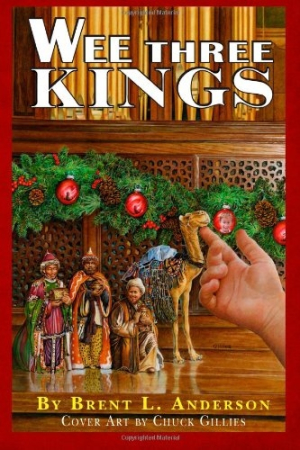Wee Three Kings
Wee Three Kings has what it takes to become a holiday classic. Older children and adults will look forward to reading it every Christmas season, and younger children will beg to hear one more chapter at bedtime every December night leading up to the holiday.
Brent L. Anderson originally started the book as a short story for his own children, but evidently the delightful group of characters took on a life of its own. Positively enchanting from start to finish, Wee Three Kings is not about the real Magi but rather three nativity-set Wise Men—and one amazing camel—who are missing the rest of their set. Steeped in Christian values and never preachy, the book charms from adventure to adventure, with hilarious moments contributed by the wee but mighty camel, Thunder.
As the story opens with young factory worker Jain hand-painting figurines on an assembly line in China, the stage is set for a different kind of Christmas story. Secretly Christian, Jain glows with a contentment not found in the other workers around him. He has been painting nativity figurines all week, and when the first cart of Wise Men arrives at his station, he takes the liberty of ignoring the work order and painting one figure to resemble his uncle. Admonished for not following directions, he nonetheless sends the set on its way, praying a special blessing upon the ceramic Three Kings and their camel. That blessing turns out to be magical.
Each Christmas season, the figurines come to life, and for one night, Christmas Eve, they are tasked with a mission of faith and goodwill that illustrates the true meaning of the holiday. Anderson presents what initially seem to be separate stories but then cleverly ties them together, bringing the story full circle and each plot line to a satisfying conclusion. His characters are so endearing and their adventures so mysterious, yet well developed, that the book is hard to put down.
That the wee characters remain their nativity-set size throughout not only adds to the absurdity of their coming to life at all but also provides an impressively creative means for them to pursue their exploits. Karate-kicking miniature Magi and a grunting, galloping, spitting camel serve as unexpected, but perfect, vehicles for the message that no one is ever too small to matter or make a difference.
The cover art for Wee Three Kings, painted by artist Chuck Gillies, is both festive and appealing, an ideal match to the story inside and a wonderful expression of Christmas spirit. The characters look exactly as the reader would imagine, and the faces alone elicit smiles. A small hand reaching out to tickle the camel’s chin begs to be replaced with the reader’s own. Illustrations within are few but fitting, several contributed by Anderson himself and one contributed by each of his three children, Caleb, Abigail, and Faith. Without question, this is a family book.
Even those who do not normally read Christian literature will be pleasantly surprised and impressed with Wee Three Kings. Never heavy-handed but clear in the values it promotes, it is an engaging story with a universal Christmas message. Beautifully written, carefully edited, and tremendously appealing, the book seems destined to become part of a family holiday tradition.
Reviewed by
Cheryl Hibbard
Disclosure: This article is not an endorsement, but a review. The publisher of this book provided free copies of the book and paid a small fee to have their book reviewed by a professional reviewer. Foreword Reviews and Clarion Reviews make no guarantee that the publisher will receive a positive review. Foreword Magazine, Inc. is disclosing this in accordance with the Federal Trade Commission’s 16 CFR, Part 255.

